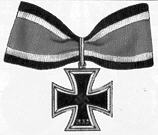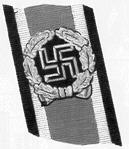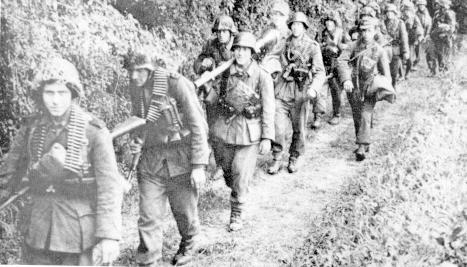Oberst Schmidthuber (commander Pz.Gren.Rgt.304), Oberstleutnant Buck (commander Pz.Gren.Rgt.2), Oberstleutnant Dous (commander Art.Rgt.74), and Major von Boxberg (commander Pz.Rgt.3) congratulate the Division Commander Generalleutant Lübbe for earning the Knight's Cross.
The 2. Panzer Division was formed in 1935. Its first commander was Heinz Guderian (the father of the Blitzkrieg). At the start of the war most of its personnel were Austrian.
The Division participated in:
Invasion of Poland;
Invasion of France;
First division to reach the Atlantic;
First division to reach the Swiss border;
A tank from the division sank a British destroyer at Boulogne;
Invasion of the Balkans;
Invasion of Russia;
Advanced to within 25 km of Moscow;
Participated in the battle of Kursk;
Fought in Russia - 1941-1943;
Fought in France (Normandy area) 1944;
Fought in the Battle of the Bulge (advanced further than any division);
Panzer Division Stab
Panzer Regiment 3
Panzergrenadier Regiment 2
Panzergrenadier Regiment 304
Panzer Aufklärungs Abteilung 2
Panzer Pionier Bataillon 38
Panzerjäger Abteilung 38
Panzer Artillerie Regiment 74
Heeres Flakartillerie Abteilung 273
Panzer Nachrichten Abteilung 38
Feldersatz Bataillon 82
Nachschubtruppen
Kraftfahrparktruppen
Verw.-Truppen
San.-Truppen
Feldpost

32 Knight's Cross Recipients

93 German Cross in Gold Recipients

32 Honor Roll Clasp of the Army Recipients
Veterans of the 2. Panzer Division still have reunions in Austria and Germany. Members of our unit have been to the reunions. We are probably one of the few reenacting units in contact with the original division.
A distinguished division that fought from the beginning until the very end.
This month's feature: Oberst Meinrad von Lauchert (promoted to General Major on March 1, 1945). He was the commander of 2nd Panzer from December 15, 1944 until March 19, 1945. He was not the last commander of 2nd Panzer.
Learn about General von Lauchert

Panzergrenadiers of the 2. Panzer Division on the Invasion Front (France 1944)
The following article is from the December 1944 issue of Intelligence Bulletin. This was a monthly magazine for NCOs and junior officers published by the U.S. War Department. I have added comments in parentheses from the book Die Friedens- und Kriegsjahre der 2. (Wiener) Panzerdivision in Wort und Bild von F.J. Strauss.
For a period of 36 hours in the last days of July (1944), an officer of an Allied army group staff had an excellent opportunity of observing German tanks and infantry of the 2nd Panzer Division attacking an Allied force in France. The following notes, which are based on this report, describe the tactics that the Germans employed.
The general situation was fluid at the time of the attack. The Germans advanced westward in three parallel columns, each consisting of tanks accompanied by infantry. The center column followed a main road, firing rapidly and moving at a brisk rate. It went from hill to hill, with the accompanying infantry dog-trotting through the fields on each side of the road and over the hedgerows. The infantry was employed over no more than the width of a single field on each side. The center column had a total of only eight tracked vehicles. At least three of these were tanks, one or two probably were self-propelled guns, and the remainder probably were half-tracked personnel carriers.
Although the total German strength which had been sent to capture and hold an important crossroads at St. Denisiere consisted of two companies of infantry and probably not more than ten tanks, the Allied officer observed only the tracked vehicles previously mentioned and possibly a platoon of infantry. (Actually about 20 tanks and 2 companies of Panzergrenadiers in half-tracks (Sd. Kfz. 251) from Panzergrenadier Regiment 304 plus some forward observers)
The Infantrymen Moved Fast
The leading tank fired its 75 rapidly, getting both graze and air bursts, while its machine guns, supplemented by those of the vehicles behind it, sprayed the top of every hedgerow. The noise was terrific, and the bursts in the shrubbery and the tops of trees and hedgerows were certainly impressive. Even before the shock of the guns discharged at close range and the garden hose spray of machine gun bullets, had taken full effect, German infantrymen were over the hedgerow and into the field and were advancing toward the next field with determination and courage. They knew where they were going and went there fast.
At night the Germans reacted forcefully with fire and limited movement, whenever they detected any sign of an Allied approach. The German tanks moved slowly, and made very little noise. Immediately after firing, each tank moved to a new position 25 to 50 meters away. It should be emphasized that the noise discipline of the German tank crews and the accompanying infantry was superior. There was no talking or shouting except for machine gun and cannon fire and the starting of motor, no sound carried farther then 100 yards.
On the other hand, the approach of US tanks and the passing of most US motor convoys was rapidly identifiable by the loud shouting, talking and issuing of orders by the US troops who approached or passed the general vicinity of a German position. The propensity of US tank drivers to "gun" their motors was a dead give-away, whereas the Germans always eased their tanks forward, traveled in low gear and were remarkably quiet in all operations except the firing. They used long bursts of their rapid-firing machine guns to discourage guests. If pressed at all, they sent up flares to obtain German artillery and mortar fire on their flanks. The way they handled their tanks was bold and sure. They acted as if they knew exactly what their destination was and by which route they wished to proceed.
A U.S. Tank "Got the Works"
At 0230, the darkest part of the night, a German tank moved out and headed toward the northernmost German column, making as little noise as possible. Later it turned out that a lone US tank on reconnaissance had pushed up against the nose of the ridge that the German tanks had organized, and the Germans were quietly laying plans to place a terrific amount of fire on it. Before long, it got the works.
Because there were so few German infantrymen and because they were interested only in reaching and holding the team's objective, their mopping-up activities were negligible. Thus, of the Allied troops overrun in this fashion, a large percentage was neither killed, wounded, captured, or missing during the first two or three days. (The Germans claimed inflicting heavy losses on the Americans and the destruction of 25 American tanks). The ease and rapidity with which this small attacking force made its penetration, reached its objective, sat on the objective and cut traffic on an important road is of more than ordinary interest. Also, it is reasonable to assume that the Germans will employ small groups for similar missions in the future.
Black and white photos were taken from the Mitteilungsblatt of the Kameradschaft der Wiener Panzer-Division. Published with permission.
Unless otherwise credited all material (c) Copyright Matthew Gajkowski 1996. All rights reserved.